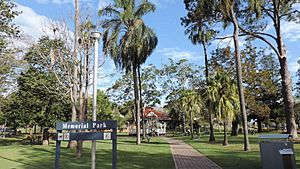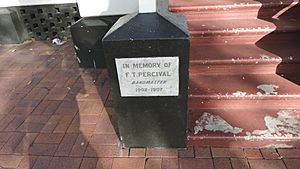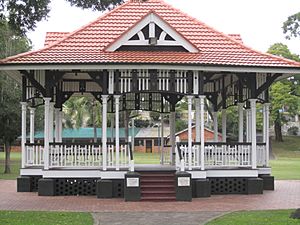Gympie Memorial Park facts for kids
Quick facts for kids Gympie Memorial Park |
|
|---|---|

Gympie Memorial Park, 2015
|
|
| Location | River Road, Gympie, Gympie Region, Queensland, Australia |
| Design period | 1919–1930s (interwar period) |
| Built | 1919–1921 |
| Architect | Harry Moore, Alfred Herbert Foster |
| Official name: Memorial Park | |
| Type | state heritage (landscape, built) |
| Designated | 18 September 2009 |
| Reference no. | 602729 |
| Significant period | 1920s |
| Significant components | trees/plantings, bandstand/rotunda, garden – layout, tree groups – avenue of, memorial/monument, garden – bed/s, flagpole/flagstaff, memorial – park, pathway/walkway, memorial – plaque, memorial – rotunda, memorial – rock/stone/boulder |
| Lua error in Module:Location_map at line 420: attempt to index field 'wikibase' (a nil value). | |
Gympie Memorial Park is a special place in Gympie, Queensland. It was built to remember brave soldiers. This park is listed as a heritage site, meaning it's an important part of history. It was designed by Harry Moore and Alfred Herbert Foster. The park was built between 1919 and 1921.
The Park's Story
Gympie Memorial Park started in 1919. It was first called the Gympie and Widgee District Fallen Soldiers' Memorial Park. The park was designed by Henry (Harry) Moore, a park expert from Brisbane. The main bandstand was designed by Alfred Herbert Foster, an architect.
The park officially opened on April 20, 1921. But its first big event was on August 3, 1920. This was when Edward, Prince of Wales, visited Gympie. The park was paid for by local people. The land was given by the Henderson family. They owned a sawmill nearby. The park was built to honour people from the area. These were soldiers who died in World War I (1914–1918) and the Boer War (1899–1902). The bandstand also remembers Mr Frederick Thomas Percival. He was a much-loved local bandmaster.
Why Gympie is Important
The park is in Nash's Gully, in central Gympie. This area is near the Mary River. In 1867, James Nash found gold here. This discovery started Queensland's first big gold rush. The town of Gympie grew quickly because of the gold. By the 1870s, Gympie was one of Queensland's richest goldfields. Gold mining slowed down by the 1920s. Gympie became a city in 1905. Before World War I, it was a busy area for timber, sawmills, and farming.
Remembering War Heroes
World War I deeply affected Australia. Over 300,000 Australians volunteered to fight. About 60,000 of them died. Almost every town in Australia lost young men. No other war has had such a big impact on Australia.
Even before the war ended, communities built memorials. These memorials honoured local people who died. They showed the nation's sadness. Since soldiers were buried where they fell, memorials became like graves at home. War memorials came in many forms. These included honour boards, stone monuments, and memorial parks.
Choosing the Park's Location
On January 9, 1919, a group of citizens met. They wanted to honour the war dead. They thought about a garden, a park, or a scholarship. Mr Arthur Henderson offered land for a memorial park. This land was where the Union Sawmills used to be. It was a triangular piece of land. It was bordered by River Road, Reef Street, and Young Street.
There were two problems with the site. First, it was hard to get to from Mary Street. Mary Street was Gympie's main shopping street. Second, the land was low and could flood. The Mary River had flooded Gympie many times. People asked Harry Moore for advice. He was Brisbane's Parks Superintendent. Moore had designed New Farm Park in Brisbane.
In February 1919, Moore visited Gympie. He liked the sawmill site. But he wanted better access from Mary Street. He also needed to know it wouldn't be badly damaged by floods.
Making the Park a Reality
People debated the park idea for months. The local soldiers' league supported the sawmill site. The Henderson family then offered more land. This extra land connected the park to Mary Street. So, on March 26, 1919, the offer was accepted. A park in the city centre would be a lasting memorial. It would also benefit the community and attract visitors.
Work began in mid-July 1919. Old sawmill buildings were taken down. Money from selling the timber helped pay for the park. Concrete drains were covered. A fence was built around the park. Local soldiers returning from war helped with the work.
Harry Moore designed the park layout. He liked curving paths, not straight ones. He used raised garden beds with rocks. These beds had bright flowers and shrubs. He often used roses. For shade, he planted palms, pines, and flowering trees. These included poinsettias and jacarandas.
Moore designed a path from Mary Street to River Road. This path was the main entrance. The Gympie and Widgee War Memorial Gates were at the Mary Street end. Vehicles could use the path on special days. But usually, it was for walking only. Inside the park, paths curved from the gates to a central bandstand.
Early photos from 1922 show Cabbage Palms along the main path. Other paths had pines and palms. There were four round or oval garden beds in the grassy areas. These beds were not edged with stone. The area east of the bandstand was open grass. This is where people sat for concerts.
The Bandstand's History
In August 1919, the Gympie City Council decided to build a bandstand. It would be in the Memorial Park. This bandstand would honour bandmaster F.T. Percival. The design was similar to one by A.H. Foster for New Farm Park. Foster was an architect for Brisbane City Council. He designed many park structures.
Foster's bandstand design was made of timber. It had a pyramid roof with new fibrous-cement tiles. It had decorative timber details. The contract was given to Mr T.J. Dale of Gympie. The bandstand was ready for the Prince of Wales' visit in August 1920. Foster also designed the park's lighting. Later, concrete stairs were added. The roof was re-tiled in the late 1960s or 1970s.
In 1919, a competition was held for the Mary Street memorial gates. George Rae, a young draftsman, won. The gates cost almost £1000. They were finished around August 1920. Plaques on the gates list the names of 167 local men who died in World War I. They also list two who died in the Boer War. The memorial gates are a separate heritage site.
The Memorial Park was given to the Gympie City Council on February 9, 1921. It was officially opened on April 20, 1921. Major-General Sir Thomas William Glasgow opened the park. He was a hero from Gympie. The park, bandstand, and gates cost over £5,500. They were opened without any debt.
The park's status became official on December 2, 1921. It was named a Reserve for Soldiers' Memorial Park. The Gympie City Council became its trustee.
Changes Over Time
In the 1920s, the Council built a fernery and public toilets. These buildings are no longer there.
The park has flooded many times. This happened in 1927, 1931, and 1954.
During World War II (1939–1945), air-raid shelters were built. They were underground, near the bandstand. These shelters could hold 20 to 30 people. They were taken down after the war.
In the 1950s, a brick nursery and fernery were built. This was along the Young Street side of the park.
Reef Street became the main road for cars to access the park. In 1944, the fence along Reef Street was removed. This made more space for parking cars. It also made the park look more open. Eventually, all the fences around the park were removed.
Other memorials have been added to the park. Around 1939, a memorial fountain for James Nash was moved here. It is near the corner of Reef Street and River Road. On Armistice Day 1988, a memorial stone was added. It honours soldiers from Gympie who served in later wars. These include the Korean War, Malaya, Borneo, and Vietnam War.
In 2013, the Gympie Regional Council suggested building a levee. This would protect the park and city from future floods.
Today, the Memorial Park is still important. It is used for annual ANZAC Day and Remembrance Day events. It is also a popular park for walking.
What the Park Looks Like
Gympie Memorial Park is just south of the main shopping area. It's a triangle of land between Reef Street, Young Street, and River Road. A walkway connects it to Mary Street. This walkway has the famous Gympie and Widgee War Memorial Gates. The park is a beautiful green space in the middle of town.
It has lawns, round and oval rose gardens, and paved paths. There are many different kinds of mature trees. The park still looks much like it did when it was first built. It is still used for many of the same activities.
Key Features
The 1920 timber bandstand is the most noticeable building. It stands near the centre of the park. Paths lead out from the bandstand in different directions. Some of these paths have rows of trees on both sides. These tree-lined paths were part of the original design. All the paths in the park are paved.
There are four garden beds in the park. One is oval, and three are round. They are in the same spots as the original beds from 1920. Three are along the River Street side. The largest one is north of the bandstand. All four beds are planted with roses.
The park has many different types of mature trees. Some are around the edge, forming a green screen. Some, like the Hoop Pines, look very old. They might be from the first plantings. Other trees include Jacarandas, Brown Pines, and Kauri Pines. The paths also have rows of trees. These include Queen Palms, Cabbage Palms, and Chinese Fan Palms. Other trees like Slash Pine, Silky Oaks, and Illawarra Flame trees are found throughout the park.
The 1920 bandstand is a timber building raised off the ground. It has a square roof with small gables on each side. The roof is covered with concrete tiles. Timber posts support the roof. There's a decorative timber frieze below the roof. The ceiling is made of timber boards. The bandstand has fixed timber benches inside. A timber fence goes around the sides. The floor is made of timber. Concrete steps lead up to the bandstand. On the main steps, there are marble plaques. One remembers F.T. Percival, the bandmaster. The other remembers soldiers from "The Great War, 1914–1918." The bandstand stands on concrete piers. Honeycomb brickwork connects these piers. The area around the bandstand is paved.
The 1950s fernery building is made of orange bricks. It has a storage room and a long, open area for growing plants. The storage room has a timber roof. The fernery has a sloped roof with steel frames. It is covered with steel caging and shade cloth. The walls are brick up to waist height. Steel caging fills the window openings.
Other memorials are in the park. The sandstone and marble monument to James Nash is very noticeable. It is in the north-west corner of the park. It faces the intersection of Reef Street, River Road, and Monkland Street. It has a square base and decorative columns. Marble panels are between the columns. One panel says: "Erected to the Memory of James Nash, who discovered the Gympie goldfield, 16th October 1867."
West of the bandstand is a "Peace Pole." It has a plaque on a timber pole and another on a rock. South-west of the bandstand is a 1988 War Memorial. It has a large sandstone boulder with a cross carved into it. There is also a granite plaque and a brass plaque. A low, curved concrete wall surrounds the boulder. It has brass plaques remembering individual soldiers. A flagpole stands nearby.
Because the park is low-lying and has many trees, views are mostly within the park. You can see parts of the park from nearby streets.
Why the Park is Special
Gympie Memorial Park was added to the Queensland Heritage Register on September 18, 2009. This means it is important for several reasons:
Showing Queensland's History
The Memorial Park was built between 1919 and 1921. It honours people from Gympie who died in World War I and the Boer War. This park shows how Australian communities grieved and remembered their soldiers. It helped shape Australia's identity in the early 1900s. It is still important for understanding Queensland's history.
A Unique Design
The Memorial Park in Gympie is one of the best examples of work by Harry Moore and A.H. Foster. They were famous for designing parks and gardens. They worked for the Brisbane City Council. The fact that they designed this park shows how popular their work was.
The park still has many of its original design features. These include the connection to Mary Street, the paths leading from the central bandstand, the round and oval garden beds, and the old trees. The timber bandstand, designed by A.H. Foster, is a great example of a park bandstand from that time.
Beautiful to Look At
The park is very beautiful. This is because its original design elements are still there. These include the bandstand, paths, garden beds, and trees. The way the park is laid out creates nice views. The rows of mature trees add to its beauty. The trees around the edge make the park feel peaceful and separate from the busy city.
Important to the Community
The park is very important to the people of Gympie. It is the main place for public events. These include ANZAC Day on April 25 and Remembrance Day on November 11. It holds special meaning for the community.
Images for kids









